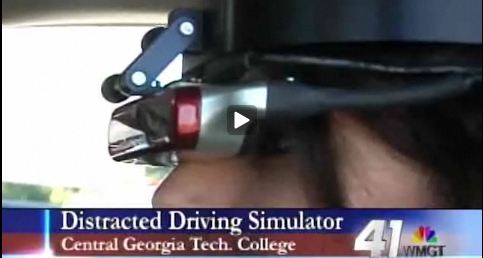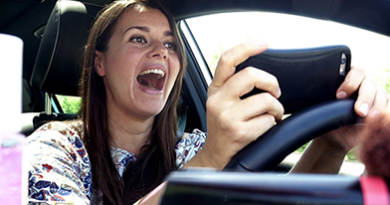Texting, drunk driving simulation visits Penn State York

For several hours Wednesday afternoon, students walking past a Jeep parked on Penn State York’s lawn by the John J. Romano Administration Building could hear the screeching of brakes, glass shattering and other signals of a vehicle collision, over and over.
The Jeep didn’t move, but the students “driving” the vehicle each had a chance to see how drinking and texting could affect their coordination and reaction time behind the wheel through simulation glasses.
Dangerous texting: Students know driving while under the influence of drugs or alcohol is always a bad idea, said Patrick Sheehy, who was in charge of UNITE’s Arrive Alive simulation program at the campus Wednesday.
But demonstrating the dangers of texting while driving, or other distracted driving habits, is also at the forefront of the simulation, he said.
Sheehy said one of his main goals during every campus visit is to provide students with information and a simulated experience that might convince them to drive sober and leave the cell phone in the console.
“Hopefully with that bit of information they can make better decisions for themselves,” Sheehy said.
For example, for every alcohol-related accident on the road, there are four texting-related accidents, Sheehy said. And in the Arrive Alive Jeep, students hit pedestrians and other cars just as quickly while texting compared to the simulation of several drinks in their system.
Student feedback: Some students, including freshman Andrew Cvek, said friends behind the wheel after drinking or while texting are equally dangerous.
“I don’t trust them if they’re texting or drinking,” Cvek said.
But behind the wheel himself, Cvek said there’s a larger temptation to text.
In the case of drinking, slowed reaction times can be a large cause for collisions, Sheehy said. But in the case of texting, people aren’t slow to hit their brakes — they don’t tap them at all.
“You don’t even slow down,” Sheehy said. “It’s like driving with a blindfold.”
Emphasize texting dangers: Freshman Kyle Bly said Wednesday was the first time he had tried a simulation. Even so, Bly said he doesn’t text while driving because of the danger.
“There’s no way I do,” he said.
And though freshman Samantha Glancey said she doesn’t text and drive either, she added the dangers of texting while driving aren’t emphasized to people her age as much as drinking.
“Texting on its own is pretty innocent,” she said, adding the simulator for texting is a good step toward also showing the dangers of distracted driving.
The program will continue to happen each fall for new students and those who didn’t stop by before, said Dan Puccio, the campus’ associate director of student affairs.
“It’s a way for them to do it in a safe environment but also realize how much harm it can cause,” Puccio said.
— Reach Nikelle Snader at nsnader@yorkdispatch.com.






You must log in to post a comment.